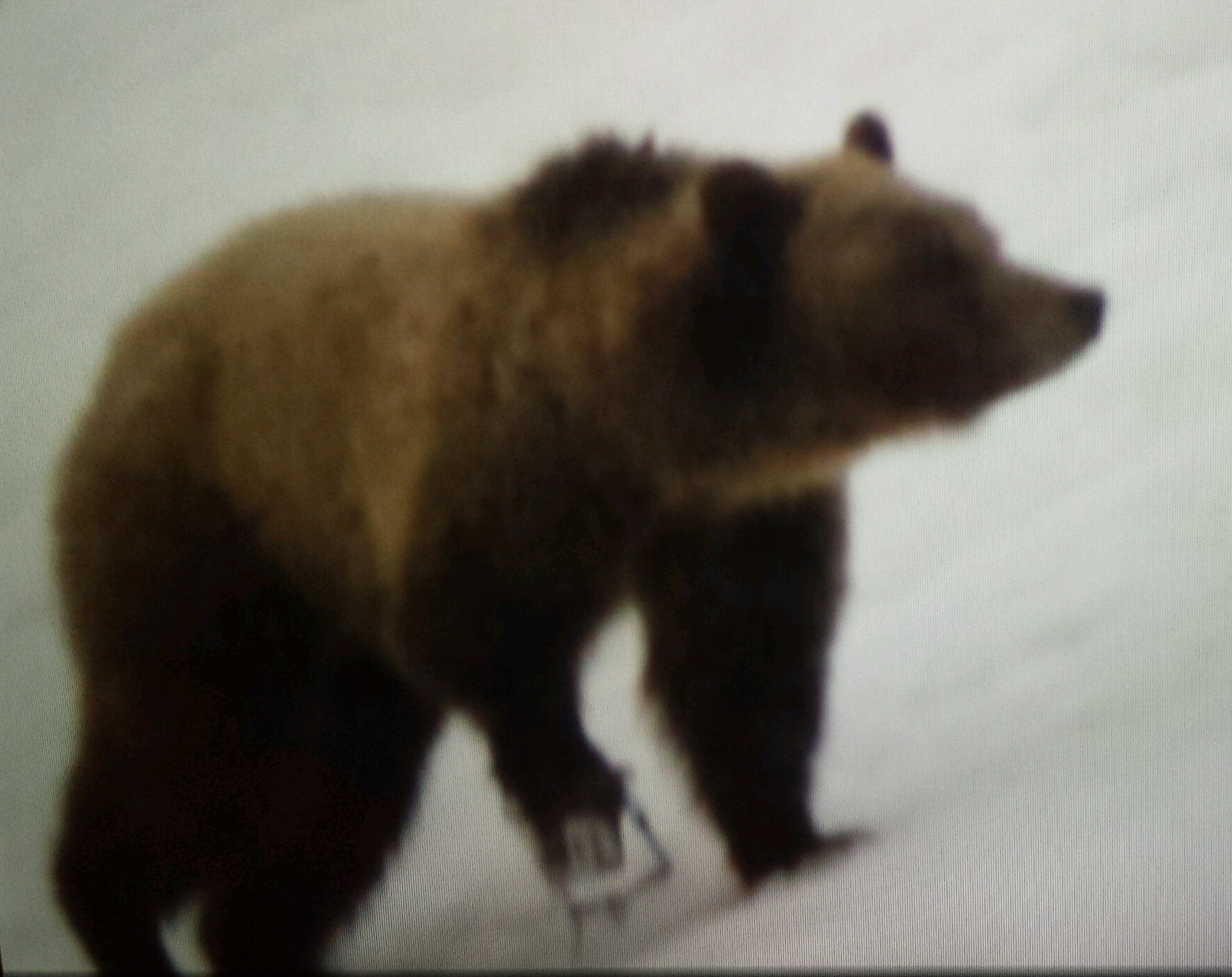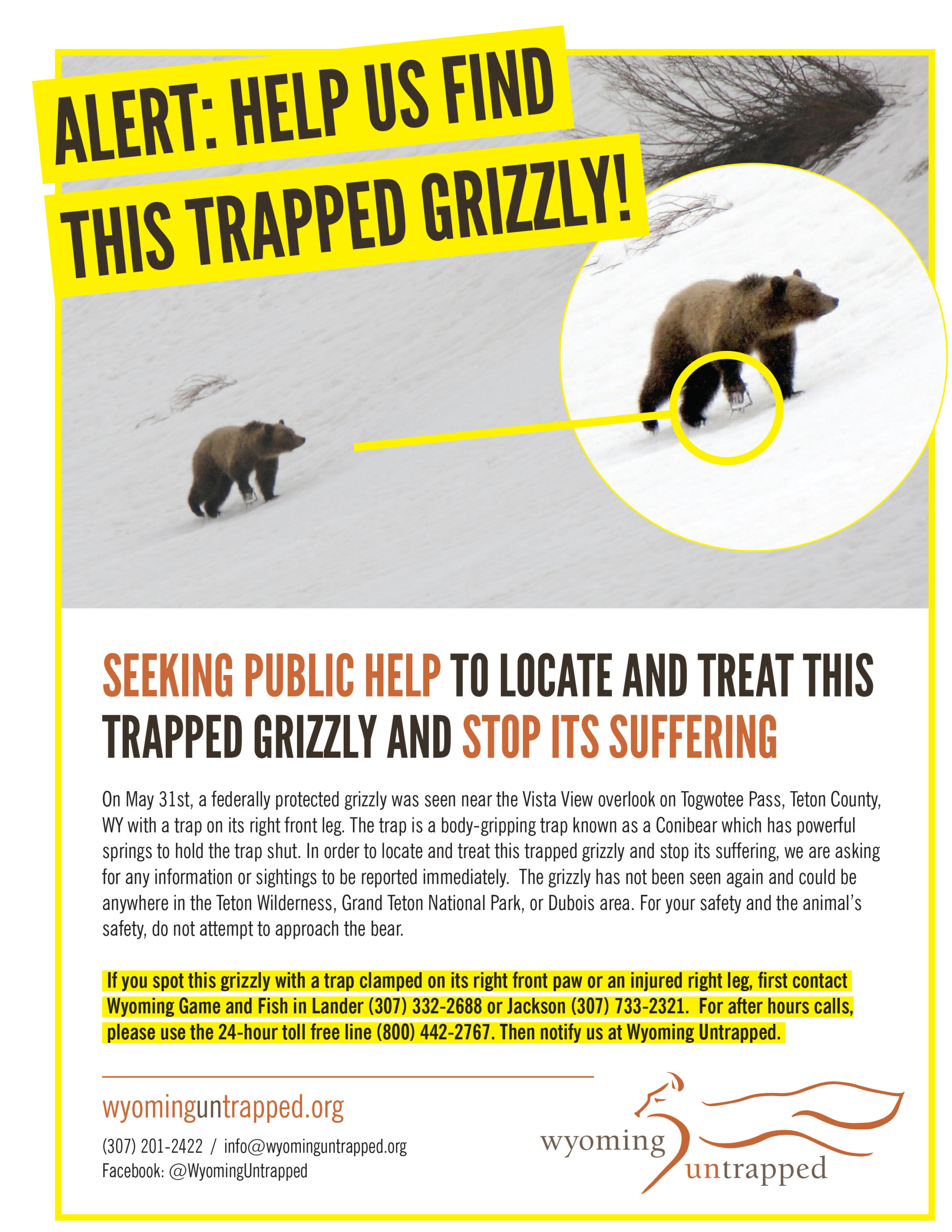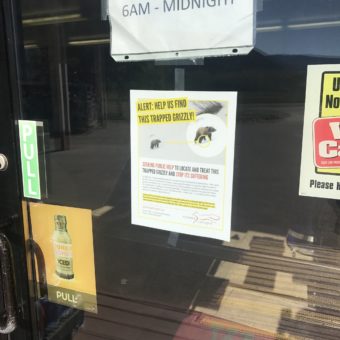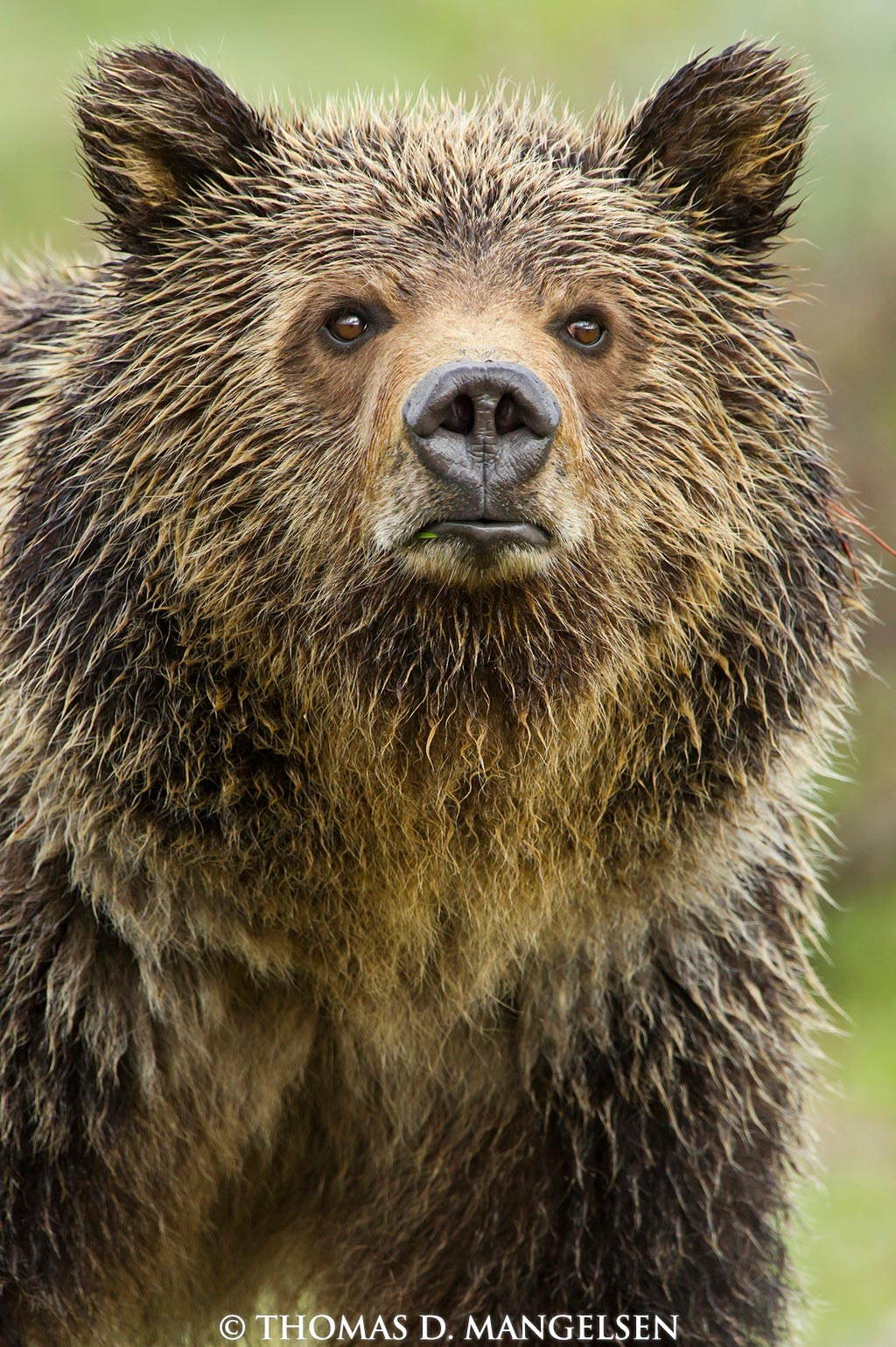Alert!
Wyoming Grizzly Bear Caught In Body Gripping, Quick-Kill Trap. Fate Unknown
- Wyoming Untrapped received a call on June 5, from a concerned citizen reporting a grizzly boar trapped in a Conibear trap in the Bridger-Teton National Forest viewed from the Vista View lookout at the top of Togwotee Pass. A local photographer witnessed the incident, and forwarded a photo to the Wyoming Game and Fish Department last Wednesday. Conibears are considered “body-gripping, quick-kill” traps. Trappers are only required to check this kind of trap once every week, although the first week of the set allows for up to 13 days of check time. This grizzly could still be carrying the attached trap, and may have been carrying it for weeks. If you are in this particular region of the Bridger-Teton National Forest—first, be aware that active traps are in the area. Second, please be on the lookout for evidence of the grizzly involved, and any details relating to the fate of the grizzly.
- Anyone spotting a grizzly with a trap stuck on its right front paw, or with an injured right leg can call Wyoming Game and Fish at the Lander Office at (307) 332-2688 or Jackson Office at (307) 733-2321. After hours or on the weekend you can contact Wyoming Game and Fish at 1-800-442-2767. Also notify Wyoming Untrapped, info@wyominguntrapped.org or 307-201-2422 We will continue to report additional information about this particular incident as it becomes available.
G
This trapping incident raises plenty of questions about the impacts trapping has on wildlife of every sort, including endangered species. What is the fate of this grizzly? How many times has this happened in Wyoming? Are our non-target reports too incomplete because of unclear, unenforced non-target reporting requirements? Why are trappers exempt from the consequences of the taking of an ESA-listed species, or other protected species without repercussions or accountability? Unfortunately, no animal is immune from the effects of trapping.
A trap on Wyoming public land has caught a protected species, a grizzly bear. Trapping makes the mentality of ‘shoot, shovel, and shut up’ all too easy, especially since non-target incidents, or ‘by catch’ are only required to be reported when the trapper deems the animal unlikely to live. That high degree of discretion inevitably leads to gaps in reporting.
We’ll keep you posted as the details surface! Please call or email with any information you may have.
Updates
- June 7, 2017
Wildlife managers are so far unable to locate the wounded animal.- see full article below
- June 9, 2017
Wildlife managers are so far unable to locate the wounded animal.- Dan Thompson – Large Carnivore Section Supervisor, WGFD. “we have actively looked for this individual….. We will continue to monitor as always. We conducted a flight directly over the area earlier this week and no bears were observed and as you know we conduct grizzly bear observation flights throughout the remainder of the summer. I do not have a copy of a photo.” But a week too late for the grizzly rescue!
Continued Updates
Photo: Cover by L. Robertson, Grizzly Face by Tom Mangelsen.
- June 14, 2017
Fate of the grizzly remains unknown.- Wyoming Untrapped requested a dedicated search for the trapped grizzly. We issued a Wyoming Public Record Request (WPRA) for access to the photo, which was finally provided on June 14, two weeks after the incident. The public learned of the trapping incident one week after the first May 31 report.
- June 16, 2017
Fate of the grizzly remains unknown.- Wyoming Untrapped met with WGFD at their Lander office, a three hour drive from our home base. We, once again, requested a dedicated search for the trapped grizzly, and an investigative search for the source of the trap. A
- June 17, 2017
Fate of the grizzly remains unknown.- Wendy Keefover, the Carnivore Protection Manager of The Humane Society of the United States, sent a letter to USFWS and the WGFD with an “urgent request to locate and treat trapped grizzly bear, and launch investigation to discover who trapped the bear.” Grizzly bears are fully protected from take or attempted take – including by trapping – under the ESA, enforceable by both criminal and civil sanctions.
- see full letter below
- June 21, 2017
Wyoming Untrapped is posting GRIZZLY ALERT FLYERS throughout Teton County. Please share.- There have also been volunteers in the field using “tracking” skills to find this grizzly.
- JHNG: The Wyoming Game and Fish Department — a state agency that anticipates soon managing grizzlies in the Greater Yellowstone region — dispatched biologists to locate the animal the day the report came in, large carnivore manager Dan Thompson said Monday. Search efforts are ongoing but have been unsuccessful so far, he said.
- Read full article below: http://bit.ly/2sTndLk
- Wyoming Untrapped is distributing ALERT flyers requesting the public to contact WGFD and WU with any sightings of the trapped grizzly.
- June 24, 2017
Fate of the grizzly remains unknown.- Volunteers and the public continue to monitor the area for the grizzly. A volunteer flew an aircraft over the area of the incident today. Photo attached.
- June 27, 2017
Fate of the grizzly remains unknown.- Update from Dan Thompson, Large Carnivore Supervisor, Wyoming Game and Fish Department: “We have not received any calls or updates from the public. We have not found evidence of a bear with a trap on its foot in our ongoing efforts – have been very active in the Togwotee area with bear activity. Flights continuing throughout the Wind Rivers through this week as well.”
- Additional ALERT flyers have been placed in JH and the Togwotee area. The public is on ALERT. Thank you everyone!
- July 11, 2017
Fate of the grizzly remains unknown.- Unfortunately, WGFD and BTNF have not received any sighting information from the public. WU is planning a meeting with both agencies to develop a strategic plan for dealing with any trapping incidents such as this in the future.
- We continue to raise awareness about the urgent need to end these traumatic non-target trapping incidents and the need for trapping reform.




Posted: Wednesday, June 7, 2017
By Mike KoshmrlA grizzly bear has been photographed on the loose near the top of Togwotee Pass with a Conibear-style furbearer trap clamped to its paw.
While it’s unknown how long the bruin has been hobbled by the steel contraption, a photograph of the bear was passed along to Wyoming Game and Fish on May 31.
Moran resident and videographer Jim Laybourn is one person who has viewed the image of the caught bear, having run into a Dubois couple shortly after they snapped the photo.
“It’s firmly attached, most of the way up its paw, and there’s no way that it’s going to get it off,” Laybourn said. “It’s really disgusting to think about that animal struggling with the trap. It’s going to be a tough existence.”
Dan Thompson, Game and Fish’s large carnivore supervisor, was more optimistic that the grizzly would be able to free itself.
“I think there’s a high likelihood that the bear has since removed that trap, because it was a smaller trap,” Thompson said. “As strong as bears are, I would expect a grizzly to be able to remove it, I would think.”
Game and Fish personnel are monitoring the situation “vigilantly,” he said, but they have not laid eyes on the animal. If it is located, the bear will be immobilized and the trap removed.
The Dubois residents who photographed and reported the trapped bear, rumored to be a boar, declined to be interviewed for this story when reached through their employers at Jackson Hole Airport.
The couple, Laybourn said, were shaken up.
“I could tell by their reaction that it was really emotional for them,” he said. “They felt horrible about that bear, and I imagine I would, too.”The Conibear trap observed on the grizzly’s paw is a quick-kill device that typically is used to trap beavers, muskrats and pine marten — all species that are not in season in Wyoming. Trapping of species classified as predators, such as red fox and coyote, is allowed throughout the year.
Employees of Wyoming Untrapped, a group that advocates for trapping reform, said the incident is evidence of the need for trapping bans in grizzly country.
“It’s frustrating that an endangered species has been caught and now we can’t find it,” said Kristin Combs, Wyoming Untrapped’s program director.
“It’s an example of why trapping is so indiscriminate and doesn’t have a place in modern wildlife management,” she said. “Now there’s a poor grizzly bear out there with a trap on its paw.”
Game and Fish’s Thompson said he could recall only one other instance of a grizzly being caught by a trap. A couple of years ago, he said, a subadult bear was trapped in the Cody area.
“It’s obviously an extreme rarity,” Thompson said.
Read Full Article: Grizzly on Togwotee Seen Dragging a Trap
Posted: Friday, June 16, 2017
Re: Urgent request to locate and treat trapped grizzly bear, and launch investigation to discover who trapped the bearDear Ms. Cooley and Mr. Talbott,
On June 7, the Jackson Hole News & Guide reported that a grizzly bear was photographed with a Conibear trap clamped to her or his foot. As you are aware, Conibears are body-gripping traps that slam shut with the intent of breaking the spine of an animal that enters one. People who have encountered these devices—usually because their pet dogs have been caught in them—are rarely able to open them, even with two hands and feet. For that reason, we are very concerned by this statement from a Wyoming Game and Fish Department official in the Jackson Hole News & Guide story: “As strong as bears are, I would expect a grizzly to be able to remove it, I would think.”
The problem with that speculative statement is that brute strength alone may not be sufficient to remove a Conibear trap; one must also be aware of how to maneuver the trap’s dual spring mechanism that closes it. But putting that aside and even if the bear is able to remove the trap itself, she or he most certainly will have sustained injuries to her or his digits, paw, or even the entire limb from the trap’s blood constriction to that portion of his body. The damage from the trap might even prove fatal to him, should an infection ensue. She or he will certainly sustain lifelong, debilitating injuries. If the bear is a female with dependent young or a breeding-age female, our concerns are elevated even more.
In my experience from interacting with persons who sustained injuries to their digits, even for a short duration, from steel-jawed leghold traps—because of attempts to free family pets—they reported to have experienced the loss of the use of those digits for a period of time.
As you can imagine, The HSUS, along with the majority of those who know about this incident, are concerned about the health and wellbeing of this bear. Therefore, we respectfully request that both agencies undertake to locate the bear as soon as possible and provide him with adequate veterinary care. It is vitally important to ensure that she or he does not become unable to sustain herself or himself because of the loss of his ability to walk and use her/his digits to forage. As we explain below, your agencies have a legal obligation to do so—but it is also the humane thing to do. Furthermore, we request that both agencies investigate how – and by whom – this bear came to be trapped, and take all appropriate actions to enforce state and federal law.
Given the paucity of grizzly bears in the lower 48 states and the record bear mortalities in 2015 and 2016, each individual counts. Further, grizzly bears are highly sentient beings and are much valued by the American public. Many members of that public have been upset by what they view as an unsympathetic response by the Game and Fish Department to this incident.
Under Section 9 of the ESA, it is unlawful for any person to “take” an endangered species. 16 U.S.C. § 1538(a)(1)(B). To “take” means to harass, harm, pursue, hunt, shoot, wound, kill, trap, capture, or collect, or attempt to engage in any such conduct. Id. § 1532(19) (emphasis added). “Take” includes direct as well as indirect harm and need not be purposeful. See Babbitt v. Sweet Home Chapter of Communities for a Great Oregon, 515 U.S. 687, 704 (1995). In fact, a take may even be the result of an accident. See National Wildlife Federation v. Burlington Northern Railroad, 23 F.3d 1508, 1512 (9thCir.1994). In other words, to “trap” an endangered animal is to “take” that animal regardless of whether the trapping results in actual injury or mortality. See Defenders of Wildlife v. Administrator, EPA, 882 F.3d 1294, 1300 (8th Cir. 1989) (“Take is defined in the broadest possible manner to include every conceivable way in which a person can ‘take’ or attempt to ‘take’ any fish or wildlife.”).
The Section 9 prohibition on take applies equally to threatened species like grizzly bears, unless otherwise specified by a species-specific rule promulgated by the Service. See 50 C.F.R. § 17.31(a). FWS allows for no exception to the prohibition of take of grizzly bears. Accordingly, grizzly bears are fully protected from take or attempted 3 take—including take by trapping—under the ESA, enforceable by both criminal and civil sanctions.
Grizzly bears are additionally protected under Wyoming state law and regulation. Even setting aside their status under federal law, the take of grizzly bears outside of a defined hunting season and area is a separate and independent violation of Wyoming statute and Game and Fish Commission regulation, punishable by civil penalties and as a criminal misdemeanor. Wyo. Stat.§23-3-102(d) (providing heightened penalties for illegal take of grizzly bears); Wyoming Game and Fish Regulations §67-4(a).
Americans are very concerned about animal welfare issues—even for so-called “scary” animals, 1 and we know from myriad polls that the American public abhors traps and trapping. This incident, unfortunately, demonstrates the appearance of a serious lack of concern for this individual animal by the very agency that may soon be managing America’s grizzly bears.
With this in mind, we ask that you launch an effort to locate and provide veterinary assistance to this grizzly bear at your earliest convenience.
Sincerely,
Wendy Keefover
Carnivore Protection Manager
The Humane Society of the United StatesRead full letter: www.wyominguntrapped.org/wp-content/uploads/2017/06/HSUS-Ltr2-WGFD-USFWS-Final.pdf
Posted: Friday, June 21, 2017
Re: Humane Society, Wyoming Untrapped urge state investigation.A national animal rights organization has jumped into the fray of what to do about a grizzly bear that’s been spotted in Teton County with a Conibear-style trap clamped onto its front paw.
The Humane Society of the United States, fearing for the animal’s ability to forage and get around, has sent a letter formally asking federal and state wildlife managers for an investigation.
“We want them to locate the bear, anesthetize it, get the trap off and treat it,” Wendy Keefover, the society’s carnivore protection manager, said in an interview. “And then secondarily, we would like both agencies to investigate the trapping. Grizzly bears right now cannot be legally trapped, even inadvertently, under the Endangered Species Act.”
The grizzly in the grip of the steel spring-loaded trap was photographed May 31 on Togwotee Pass traversing a large snowfield.
The Wyoming Game and Fish Department — a state agency that anticipates soon managing grizzlies in the Greater Yellowstone region — dispatched biologists to locate the animal the day the report came in, large carnivore manager Dan Thompson said Monday. Search efforts are ongoing but have been unsuccessful so far, he said.
“Not including myself, at least three people have put in about 50 hours on the ground looking for this animal,” Thompson said. “And I’ve spent countless hours responding to email and phone call allegations that we haven’t been looking.”
Game and Fish personnel were unable to locate the bear’s tracks after the sighting, Thompson said. Capturing the bear in a culvert trap wasn’t a viable option, he said, because of its remote location and persistent snow.
Keefover worried that the bear would not be able to take the trap off on its own and could lose part of its paw, or get a sepsis infection and die.
“I know people whose dogs have got into Conibears, and they can’t open them with two hands and two feet,” she said. “So to presume a bear could get one off is not reasonable.”
Thompson had a different opinion.
“I think there’s a high likelihood that the bear has since removed that trap, because it was a smaller trap,” he said. “As strong as bears are, I would expect a grizzly to be able to remove it, I would think.”
The Jackson Hole group Wyoming Untrapped acquired a photo of the caught grizzly from Game and Fish using a public records request after the agency declined to release the image.
Reviewing the photograph the organization’s staff says that the trap connected to the bruin’s paw is a 220-style Conibear. It’s a device that is commonly used to trap raccoon, skunk, fisher, bobcat, lynx and similar-size furbearers, according to TrappingToday.com. It’s designed to grip animals tightly by the body and kill swiftly.
Lisa Robertson, Wyoming Untrapped’s founder, urged state managers to intensify their investigation.
“We ought to seek the source of this possibly illegal trap and treat it like we would poaching,” Robertson said. “Trapping incidents are mostly pushed under the radar. I think that’s why we were not notified — we just found out from a concerned citizen.”
Wyoming Untrapped plans to distribute fliers around Jackson notifying residents and visitors of the grizzly that may still be in a Conibear trap.
Read full JHNG article: http://bit.ly/2sTndLk
Contact Mike Koshmrl at 732-7067, env@jhnewsandguide.com or @JHNGenviro.




violeta svabauskiene
Trappic must end.It’s horible
Lynn
Outrageous that they waited two weeks before deciding to do something about it…and that they kept it quiet from the public.
Wyoming needs to respond and make an effort to right this wrong. The bear might still be saved. They are amazing and can endure. Surely there is more than one way to track this magnificent creature.
Why are traps alllowed there anyway? These days, trapping animals for pelts and food is no longer a mountain man necessity. It’s the twentieth century! It should be illegal to trap. Period.
Bob Ro
In my opinion trapping should be outlawed no matter what kind a trip you cannot tell me it does not injure the animal involved. Let’s be real and honest no way animal that strapped needs to be in a steel clamping device there must be better ways to befriend our animals
Losa
Barbaric sick These traps should be outlawed!!!! Anyone selling should face jail time!!!!
Sandy Torres
We should respect the bears
They matter in the ecosystem and we should stop the cruelty from unjust killing games.
Ramona Carlson
Please help save the Bear.
Lindsay DeLyon
These traps should be outlawed. Its far overdue to remove these horrible things all together. These poor animals should never have to suffer like this.